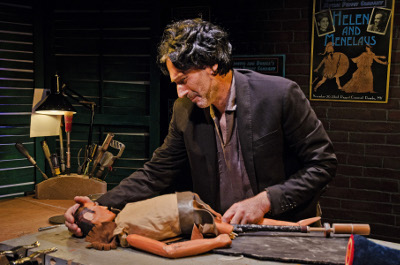
Brandon Judell
"Gepetto"-- The Puppeteer vs. The Superhero "Gepetto"
Jonathan Clark (Kevin Costner), Kal-El’s adoptive father, certainly doubts that likelihood. (Maybe he saw “E.T.”) After the 13-year-old Clark (Dylan Sprayberry) rescues his classmates, who are about to drown in a submerged school bus, thus placing his assumed identity in jeopardy, Dad reprimands him. Should Clark have let everyone die? Dad seems to say, “Yes.” And later, Jonathan gives up his life to safeguard his son’s secret. Why? The world, Dad feels, is not ready for another belief system. And is a god ready for mankind? Sadly, the intriguing complexities of these notions are abandoned by the second half of “Man of Steel,” which subsides rather briskly into a confusing, generic action film. However, the power of myth and its curative energy, plus its capability of allowing us to see ourselves as we are and can be, causes no fear in the Concrete Temple Theatre’s (CTT) latest scintillating production, “Geppetto.” Inspired by both “Pinocchio” and “The Old Man and the Sea,” here is an hour-long journey into loss, creativity, and the lessons learned from the sagas of old. Masterly written and directed by Renee Philippi, plus heart-rendingly performed by Carlo Adinolfi, who also designed the production, we catch up with Geppetto as he’s preparing for the next performance of his puppet show. The play he’ll be enacting is based on the grand love story of Perseus, who slays a sea monster to save his beloved Andromeda. Geppetto, however, is in mourning for his beloved wife and artistic partner, who has recently died. He’ll now have to perform both male and female parts. Vocally that’ll be easy enough, but how will he physically manipulate both the characters and the special effects (e.g. seagulls, waves)? While trying to overcome his sorrow and the mechanical problems at hand, his puppet Omino, who portrays all of the male heroes, has an accident. His legs are broken. How can a limbless hero save the day and how can a loveless puppeteer carry on? “I can’t do it all alone!” Geppetto cries. “I can’t be two people!” But, of course, he will. Moving from one myth to another (Helen and Menelaus) or sometimes just alluding to them with a poster (Orpheus and Eurydice), the artist, whose confidence in the higher powers will one day transform a piece of wood into a living son, regains his will to survive. A deceased love is not necessarily a dead love he learns, and the essence of a myth is not just a fantasy, backing up Joseph Campbell’s argument, “Shakespeare said that art is a mirror held up to nature. And that’s what it is. The nature is your nature, and all of these wonderful poetic images of mythology are referring to something in you. When your mind is ‘trapped’ by the image out there so that you never make the reference to yourself, you have misread the image.” “Geppetto” frees us with grace and whimsy and intelligence, no doubt aided by the astute lighting of Casey McLain and the original music of Lewis Flinn as beautifully played by celloist Jeanette. |
| museums | recordings | coupons | publications | classified |

